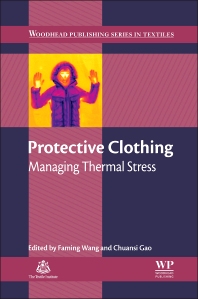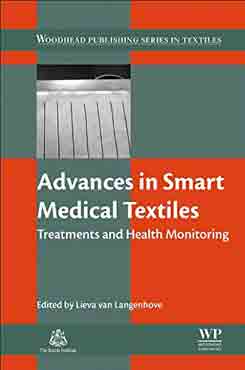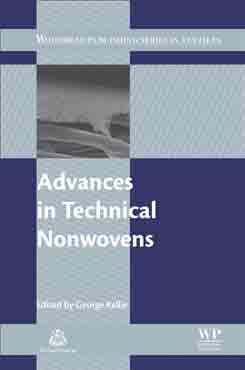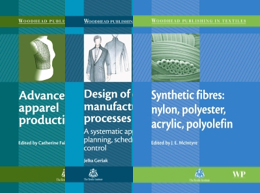Description
Protective clothing protects wearers from hostile environments, including extremes of heat and cold. Whilst some types of protective clothing may be designed primarily for non-thermal hazards (e.g. biological hazards), a key challenge in all protective clothing remains wearer comfort and the management of thermal stress (i.e. excessive heat or cold). This book reviews key types of protective clothing, technologies for heating and cooling and, finally, modeling aspects of thermal stress and strain.
Key Features
- Explores different types of protective clothing, their uses and their requirements, with an emphasis on full-scale or prototype clothing, including immersion suits, body armour and space suits
- Considers novel and commercial technologies for regulating temperature in protective clothing, including phase change materials, shape memory alloys, electrically heated clothing and air and water perfusion-based cooling systems
- Reviews the human thermoregulatory system and the methods of modelling of thermal stress in protective clothing through various conditions, including cold water survival and firefighting
Readership
Table of Contents
-
- Part I: Types of protective clothing and their requirements
- 1. Cold-protective clothing: types, design and standards
- Abstract:
- 1.1 Introduction: types of cold-protective clothing
- 1.2 Human responses to cold
- 1.3 Requirements of cold-protective clothing
- 1.4 Design of clothing to protect wearers from the cold
- 1.5 Examples and applications of cold-protective clothing
- 1.6 Standards and testing for cold-protective clothing
- 1.7 Conclusions: key challenges in managing thermal stress in the cold
- 1.8 Future trends
- 1.9 Source of further information and advice
- 1.10 References
- 2. Cold-water immersion suits
- Abstract:
- 2.1 Introduction
- 2.2 Maintenance, fit and sizing of immersion suits
- 2.3 Thermal ratings for immersion suits
- 2.4 Managing thermal protection/stress associated with cold water: the problem of water ingress
- 2.5 Assessing the performance of immersion suits in resisting water ingress
- 2.6 Protecting airways and hands
- 2.7 Active heating systems for immersion suits
- 2.8 Effect of environmental factors and flotation position on performance of immersion suits
- 2.9 Conclusions and recommendations
- 2.10 References
- 3. Clothing for protection against heat and flames
- Abstract:
- 3.1 Introduction
- 3.2 Types of clothing for protection against heat and flames
- 3.3 The human response to heat
- 3.4 Requirements for heat- and flame-protective clothing
- 3.5 Challenges in managing thermal stress
- 3.6 Design of clothing for protection against heat and flames
- 3.7 Future trends
- 3.8 Conclusions
- 3.9 References
- 4. Clothing for protection against hot-liquid splash and steam hazards
- Abstract:
- 4.1 Introduction
- 4.2 Requirements of clothing for protection against hot-liquid splash and steam hazards
- 4.3 Assessment methods and standards
- 4.4 Examples and applications of protective materials
- 4.5 Thermal stored energy and its contribution to burn injury
- 4.6 Conclusions and future trends
- 4.7 References
- 5. Chemical, biological, radiological and nuclear (CBRN) protective clothing
- Abstract:
- 5.1 Introduction
- 5.2 Types of chemical, biological, radiological and nuclear (CBRN) threats
- 5.3 Personal protective equipment for specific routes of exposure
- 5.4 Respiratory protection
- 5.5 Total body protection
- 5.6 Standard test methods for evaluating chemical-protective materials
- 5.7 Standard test methods for evaluating whole CBRN ensembles
- 5.8 Impact of wearing CBRN protective clothing
- 5.9 Conclusions and future trends
- 5.10 Sources of further information and advice
- 5.11 References
- 6. Ballistic-protective clothing and body armour
- Abstract:
- 6.1 Introduction
- 6.2 UK military ballistic-protective clothing
- 6.3 Environmental operating conditions
- 6.4 Test methods
- 6.5 Thermophysiological aspects
- 6.6 Conclusions and future trends
- 6.7 References
- 7. Spacesuits: development and design for thermal comfort
- Abstract:
- 7.1 Introduction
- 7.2 US spacesuit systems
- 7.3 History and evolution of the spacesuit
- 7.4 Challenges related to thermal comfort
- 7.5 Physiological design
- 7.6 Challenges related to glove function
- 7.7 Future trends
- 7.8 Conclusions
- 7.9 References
- 7.10 Appendix: abbreviations
- 8. Medical protective clothing
- Abstract:
- 8.1 Introduction
- 8.2 Key requirements for surgical gowns: protection
- 8.3 Key requirements for surgical gowns: thermophysical comfort
- 8.4 Limitations of current surgical gowns
- 8.5 Performance of surgical gowns: a case study
- 8.6 Measuring the thermal and water vapour resistance of surgical fabric assemblies
- 8.7 Thermal comfort attributes of various fabric assemblies
- 8.8 Thermal comfort attributes of various surgical ensembles
- 8.9 Conclusions and future trends
- 8.10 References
- 1. Cold-protective clothing: types, design and standards
- Part II: Technologies for warming or cooling in protective clothing
- 9. Phase-change materials (PCMs) for warming or cooling in protective clothing
- Abstract:
- 9.1 Introduction
- 9.2 Principles and types of phase-change materials (PCMs)
- 9.3 Incorporating PCMs into clothing for warming and cooling
- 9.3.5 Smart textiles
- 9.4 Factors determining PCM warming and cooling effects
- 9.5 Applications of PCMs for warming or cooling
- 9.6 Standards and testing
- 9.7 Challenges and future trends
- 9.8 References
- 10. Shape-memory alloys (SMAs) for warming or cooling in protective clothing
- Abstract:
- 10.1 Introduction
- 10.2 Principles of shape-memory alloys (SMAs)
- 10.3 Incorporating SMAs into clothing for warming and cooling
- 10.4 Standards and testing
- 10.5 Conclusions and future trends
- 10.7 Acknowledgements
- 10.6 Sources of further information and advice
- 10.8 References
- 11. Electrically heated clothing (EHC) for protection against cold stress
- Abstract:
- 11.1 Introduction
- 11.2 Design requirements for electrically heated clothing (EHC)
- 11.3 Heat transfer processes in EHC
- 11.4 Key components in EHC
- 11.5 Performance assessment of EHC
- 11.6 Conclusions and future trends
- 11.7 Sources of further information and advice
- 11.8 References
- 12. Air and water perfusion-based personal cooling systems (PCSs) to protect against heat stress in protective clothing
- Abstract:
- 12.1 Introduction
- 12.2 Basic requirements of personal cooling systems (PCSs)
- 12.3 Design parameters of PCSs
- 12.4 Assessing the performance of PCSs
- 12.5 Conclusions and future trends
- 12.7 Acknowledgement
- 12.6 Sources of further information and advice
- 12.8 References
- 9. Phase-change materials (PCMs) for warming or cooling in protective clothing
- Part III: Understanding and modelling thermal stress in protective clothing
- 13. The human thermoregulatory system and its response to thermal stress
- Abstract:
- 13.1 Introduction: the physiology of heat balance
- 13.2 Physiological adaptations in response to heat or cold
- 13.3 Heat stress and thermoeffector responses: sweating
- 13.4 Heat stress and thermoeffector responses: cutaneous vasodilation
- 13.5 Thermoregulation during challenges to human heat balance
- 13.6 Nonthermal modulators of thermoeffector responses
- 13.7 The body’s capacity to dissipate heat and its impact on performance
- 13.8 Factors affecting heat-stress response: physical characteristics/body composition and fitness
- 13.9 Factors affecting heat stress response: heat acclimation
- 13.10 Factors affecting heat stress response: sex, age and chronic disease
- 13.11 Factors affecting heat stress response: hydration
- 13.12 Factors affecting heat stress response: cardiovascular function
- 13.13 Conclusion
- 13.14 References
- 14. Modelling of cold stress and cold strain in protective clothing
- Abstract:
- 14.1 Introduction
- 14.2 Cold-related injuries
- 14.3 Assessment of cold stress
- 14.4 Modelling of cold strain
- 14.5 Work practices for cold workplaces
- 14.6 Conclusions
- 14.8 Acknowledgements
- 14.7 Sources of further information and advice
- 14.9 References
- 15. Cold-exposure survival and modeling offshore antiexposure garments
- Abstract:
- 15.1 Introduction
- 15.2 Hypothermia without immersion
- 15.3 Medical consequences of hypothermia during immersion in cold water
- 15.4 Expected survival time for accidental immersion
- 15.5 Certification of antiexposure suits
- 15.6 Human thermal models applied to testing of antiexposure suits
- 15.7 Validation of a human thermal model for antiexposure suit testing
- 15.8 Results from modeling and experimental studies
- 15.9 Interpretation of the CORD data
- 15.10 Summary
- 15.11 References
- 16. Modeling heat stress and heat strain in protective clothing
- Abstract:
- 16.1 Introduction
- 16.2 The body’s microenvironment and thermal stress
- 16.3 Effects of protective clothing and work conditions
- 16.4 Modeling heat stress in protective clothing
- 16.5 Future trends
- 16.6 Sources of further information and advice
- 16.7 References
- 17. Modeling thermal skin burning in protective clothing
- Abstract:
- 17.1 Introduction
- 17.2 Skin: function and structure
- 17.3 Skin burns
- 17.4 Heat transfer in the skin
- 17.5 Modeling skin burns
- 17.6 Skin burns in protective clothing
- 17.7 Future trends
- 17.8 Conclusions
- 17.9 References
- 13. The human thermoregulatory system and its response to thermal stress
- Index
- Part I: Types of protective clothing and their requirements












